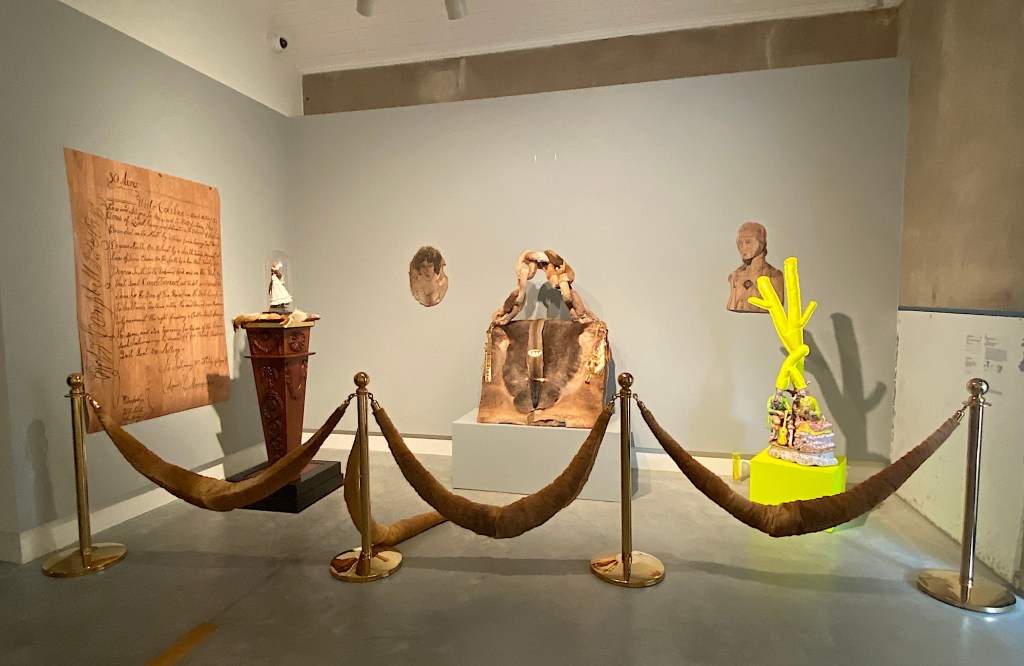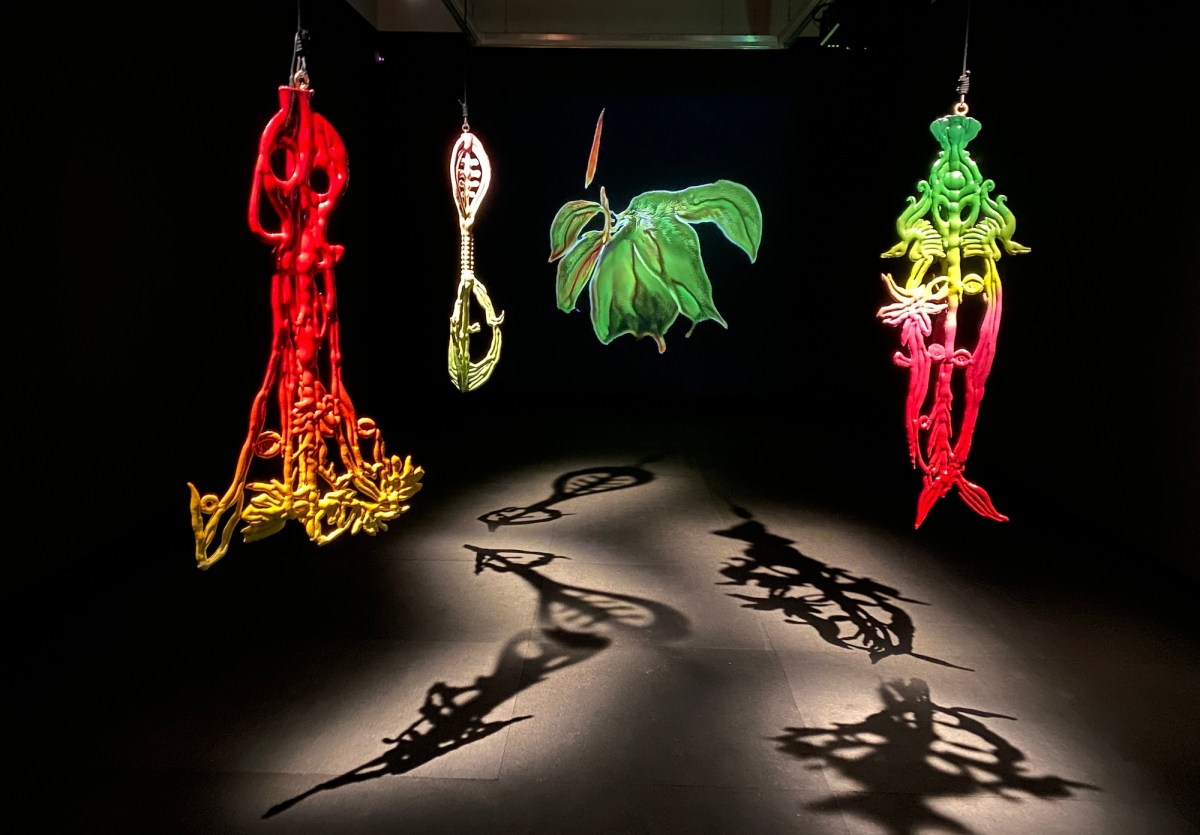While Australian artists, Joan Ross and Caroline Rothwell may have both been born in the UK, this exhibition shows that their connections run far deeper than geography. The two have used their practice to raise questions about how we live on Country. As Dr Lisa Slade writes simply, for the exhibition brochure: ‘Ross and Rothwell both summon us to face history.’
The connections, however, continue. Both share a rampant distaste for colonial arrogance, a passion for material language, a rich embrace of narrative, an irreverent and engaging sense of humour – which they use as a critical tool – and a keen eye on an escalating climate emergency.
The works are hung in adjacent galleries, rather than interspersed, allowing one to read Ross’ and Rothwell’s pieces as individual bodies of work, not diluted or coupled by a curatorial theme.
The first space is occupied by Joan Ross, with her signature fluoro yellow connecting works dating back 15 years, to one only recently made. It is a bit of a cornucopia – some works wall-mounted, others sculpture, some object-based and in vitrines that run the length of the small gallery. There is even a section roped off by stuffed kangaroo tails.
While the reading of Ross’ objects are initially as light play and folly, they are seated in deep research that interweaves the machinations of white and black histories, and the transfer of power. In many works, it is about offering agency to marginalised voices within that history.

Among the highlights here is an enormous handbag created from a kangaroo hide and titled Colonial bounty (2005) and a 3D painted sculpture of a dandy riffing off Victorian porcelain and recreated using new technologies. Oversized and engaging, it is titled, I didn’t realise how much I loved you, (2022).
The museum cases continue that play with scale, and include everything from knickers to coral, to figurines and specimens, all collected with a wunderkammer zeal for the strange and exotic. It is a feast for the eyes and a hit with visitors – while opening the door on familiar narratives.
The second, larger gallery has been turned over to the works of Rothwell, which again are both wall-based and free-standing. Central to the space, a sculptural installation pairs charred wood totems, which look like a ladder that has fallen from a high tightrope. It is twisted and slumps, its familiar form is pink. Another ladder lies on the floor and nearby a slumped chair leans against a wall.
One can’t help but be reminded of the twisted metal from the heat of raging bushfires that sweep indiscriminately with such force.
Around the walls are works form Rothwell’s Carbon Emission series, images she has created from the soot collected from car exhaust pipes, as well as soot from the 2019 NSW bushfires. It has been used to paint on glass, and then also has been animated digitally.
Another sculpture has a rambling bronze form, distilled back to hold various objects – a rock, charred wood (aka carbon), a beaker of water (called a storm glass) and an antique glass eye. They perhaps mask a darker narrative here in Retort #2 (2017), which touches on Rothwell’s interest in geoengineering experiments. While on one hand the works are perfectly balanced, as with the limbs of a tree, on the other they also point to our desire to control and force nature to align with our desires for gain. Rothwell offers an elegant and subtle debate on both our climate emergency, and our role within it.
Across her work, Rothwell calls on materials, and their patina of history, to give weight to her narratives, which are at once abstracted and yet familiar enough to evoke emotion in viewing audiences.
The next gallery is also handed over to Rothwell’s work, but the tone shifts here. Three sculptures hang in the space with a baroque opulence and a punchy pop palette that feels more akin to street art and advertising placards. They are luscious, and feel like a twist of jelly snakes, and yet they also have a bodily quality easily read as lungs and limbs.
On an end wall is the video, Infinite Herbarium Morphosis #6 (2021), where Rothwell has collaborated with Google Creative Labs to arrive at futuristic hybrid plants derived from images contained within the open source resource, Biodiversity Heritage Library.
The last space presents four of Ross’ video works – one per wall, facing off in a kind of whole body immersion. They include her signature pieces: Barbie Bush (2010), Colonial Grab (2015), I give you a mountain (2018) and Let’s party like it’s 1815 (2022).
They are easy to watch, and they engage viewers with an ease that is a great fit for a regional gallery and audiences new to video. The message, however, is clear in these works – they weave stories ranging from colonial natural history museums, to climate change, to questions of responsibility and dealing with our legacy. As Ross writes: ‘I see Australian colonisation as a car crash; in slow motion, we watch the lack of regard and insensitivity … now it’s left for us to clean up.’
Read: Yayoi Kusama next up for 2024 NGV summer exhibition
Hers is a superbly cohesive and probing practice that is so richly layered and yet driven in such a considered way. It is echoed by Rothwell’s similar dedication – two great women artists of our times.
Ngununggula continues to impress. The standard of exhibitions is extremely high, and the delivery and presentation of them on par with any major city museum. What is important in its programming is this kind of doubling – intelligent artists who are pushing their contemporary practice and medium range, to an ever present rebalancing of a First Nations perspective.
Ross & Rothwell: in the same boat
Ngununggula, Southern Highlands Regional Gallery
Bowral
17 February – 5 May 2024
Free





